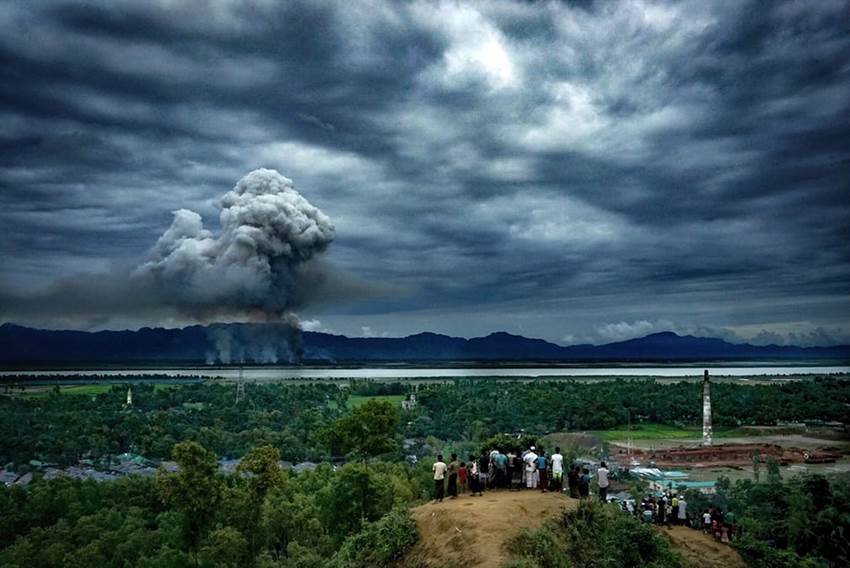As Rohingya villages in Myanmar’s Rakhine State were set alight last month, the military and civilians lined up to shoot, hack and beat defenceless villagers to death as they tried to escape. In the last few weeks, a mass exodus of more than a quarter of a million Rohingya, terrorised and starving, have fled towards the Bangladeshi border – a frontier that the Burmese military, known as the Tatmadaw, have booby trapped with land mines. This unfolding tragedy is a reminder that some people are considered superfluous. It’s a reminder that some lives matter less than others and that some people are sacrificed to serve the political and economic ends of others.
For years, human rights organisations have been warning that the Rohingya, routinely labeled ‘the world’s most persecuted people,’ are facing an impending genocide. When I was last there in 2014 I was aghast at how ingrained anti-Muslim sentiment had become in Burmese culture, and how it was manifesting in everyday life. At Bogyoke Aung San Market in Yangon, Muslim traders spoke of increased discrimination and told me how they’d lost their livelihoods because many Burmese Buddhists had boycotted their businesses.
Everywhere I went, people – usually unprompted – wanted to share their own version of the myth of the marauding Muslim masses; it was obvious, even then, that a dangerous mix of racism and conspiratorial thinking had taken root in the country. If something wasn’t done to stop the Muslims, a Burmese Buddhist told me as we stood at the entrance to Shwedagon Pagoda, Myanmar would become like Pakistan. Pakistan, he said, once had a thriving Buddhist population, until the Muslims came along and killed, converted and drove them from the country. I heard several different accounts of Muslims taking Buddhist brides as a tactic for spreading their faith (‘love jihad’). There were also the predictable tales of rape and murder; inevitably, these isolated incidents were widely reported in the media and formed the basis of many sweeping generalisations.
The thing that was most disquieting though, was that overwhelmingly, the racism wasn’t characterised by hatred but by a far more destructive force: fear. Many spoke vaguely of an inevitable, impending conflict. But when proffering a kind of preordained justification for whatever was to ensue, their accounts took on a degree of consistency that suggested they’d all imbibed the same propaganda: Buddhists were a non-violent, peace-loving, compassionate people pitched against inherently violent, immoral Muslims. In a country where Muslims make up only around four per cent of the population, Buddhists routinely explained to me how Islam posed an existential threat to their faith and nation.
Since his release from prison in 2012, Wirathu, the monk famously dubbed ‘The Face of Buddhist Terror’ by Time magazine, has lead the anti-Muslim movement in Myanmar. He has long called for the Rohingya to be expelled from the country and wants laws prohibiting marriage between Buddhists and Muslims. At mass rallies attended by thousands, he holds court, leading anti-Muslim chants and delivering sermons inciting genocide. In a country where monks are revered, this saffron-robed Buddhist supremacist provides the moral legitimacy to those who are now slaughtering the Rohingya.
The government continues to let Wirathu deliver his hate speeches, Aung San Suu Kyi tacitly endorses his message, and the Rohingya go on being murdered and driven from the country. But none of this is happening in a vacuum; when, the other day, Suu Kyi referred to the ‘terrorists’ spreading misinformation, she was just doing what other governments have done to justify their extrajudicial persecution of Muslims (think, for example, of the United States’ drone assassination program; or China’s persecution of Uyghurs; or Russia’s campaign against Chechens; or, indeed, Australia’s treatment of refugees).
What’s happening now in Rakhine State hasn’t come out of the blue. The Rohingya have long been the targets of a murderous campaign to cleanse Burmese lands of their presence. This is a program that has been in place for years. It’s a program that has wide support in both the military and government now, just as it did last year when the United States lifted sanctions and celebrated Myanmar’s ‘transition to democracy’.
The Tatmadaw are ethnic cleansers, but much of the world is complicit. Despite a long and well-documented record of war crimes and crimes against humanity, Australiaprovides them with defence training and support. Moreover, governments that have used Islam opportunistically to serve their own political ends have played a role in the unfolding tragedy too. Those who’ve uncritically showered praise of Aung San Suu Kyiand her government while she’s refused to even say the word ‘Rohingya’ (a dog whistle to Buddhist supremacists who refer to the ethnic minority derogatively as ‘Bengalis’) have wilfully ignored the simmering tension and impending violence.
‘Never Again’ is the empty platitude adorning memorials at Auschwitz, Srebrenica and Kigali. But governments sit on their hands and remain silent as other nations make preparations for genocide. Now, with the killing underway, they line up to express their ‘concern’. But now it’s too late.
(This was originally published in Overland on 12th September, 2017.)

